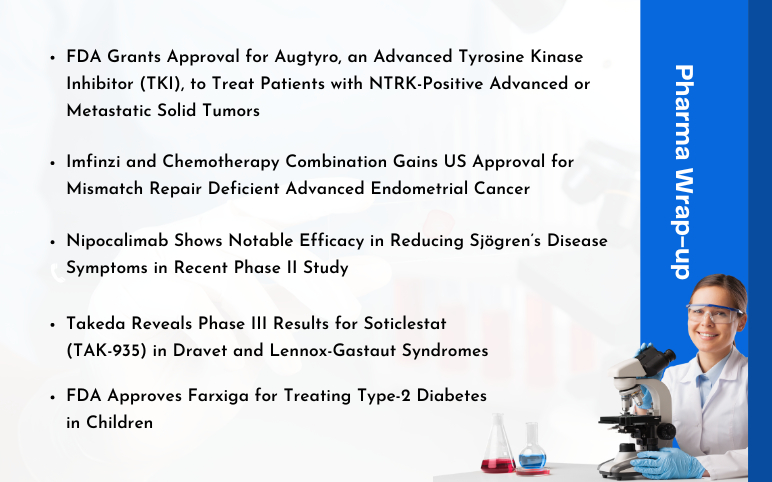The testing involves genotype study and the phenotypic changes and examination of family history for confirmed Dravet syndrome diagnosis. The time of the onset of the symptoms merely coincides with the cycles of immunizations. This makes some people believe vaccinations to be a cause of Dravet syndrome. However, it is a false belief and should be condemned.
Dravet Syndrome Treatment Market
Dravet syndrome treatment options include several pharmacological and surgical approaches.
However, there is NO CURE for Dravet syndrome. Most of the available prophylactic treatment options in the Dravet syndrome market aim to cease prolonged convulsions, reduce overall seizure frequency, and minimize the treatment side effects. The first-line therapeutics comprise anti-seizure medications such as clobazam (Onfi, Frisium) and valproic acid (Depakote, Depakene). Stiripentol (Diacomit), topiramate (Topamax) are the second-line treatments. Third line treatments include clonazepam (Klonopin), levetiracetam (Keppra), zonisamide (Zonegran), ethosuximide (Zarontin). Surgical approaches for Dravet syndrome patients are limited. However, deep brain stimulation and vagal nerve stimulator (VNS) are effective up to a certain extent in decreasing the frequency of seizures.
It is to bear in mind that medications, including sodium channel blockers (such as carbamazepine (Tegretol), oxcarbazepine (Trileptal), lamotrigine (Lamictal), vigabatrin (Sabril) and others) are not prescribed to Dravet syndrome patients because these are known to provoke seizures and status epilepticus.
The ketogenic diet is also advised to patients with Dravet syndrome. The concept of putting patients on the ketogenic diet is to maintain high fat, low carbohydrate, and adequate protein in the body. Several studies have show ket diets promisingly reduces the frequency of seizures. Basis of the results lay on the hypothesis that an increase in the metabolism increases acetoacetate, which is the primary molecule to reduce seizures in mouse models (Jansen FE et al.).
The above-mentioned therapies in the 7MM dominate the current Dravet syndrome market. As per DelveInsight, the Dravet syndrome market size was estimated to be USD 79.1 Million in 2017, which is expected to increase at a significant CAGR during the study period (2017–2030) owing to pipeline therapies to be launched in coming years. Among all the geographies studied, the United States accounted for the largest Dravet Syndrome market size. Among EU5 countries, the United Kingdom had the maximum chunk occupied with Spain accounting for the lowest Drave syndrome market share.
However, medications available in the Dravet syndrome market are partly effective and aim to reduce the incidence of seizures. The medications have side effects and work differently due to the complex pathophysiology of the disease. There are no treatment options to address the concerns of significantly high premature mortality because of status epilepticus, accidents, and sudden unexpected death in epilepsy (SUDEP). The delay in diagnosis is also a considerable concern. This not only adds to the cost but also aggravates the risk of status epilepticus, worsens cognitive outcome and invites invasive testing, and use of ineffective therapies. Still, the outstanding aim of the Dravet syndrome treatment market’s outstanding aim for a treatment offering seizure freedom and normal cognitive development remains unrealized.
Dravet Syndrome Market: Pipeline Therapies
However, the dynamics of the Dravet syndrome market are anticipated to change during the forecast period. Cannabinoids and fenfluramine are under trials for a long time to study their efficacy and safety in treating seizures. In an unusual move, the US FDA gave its approval to the first prescription cannabidiol (CBD), Epidiolex, a drug of GW Pharmaceuticals, in 2018 for the treatment for seizures associated with Lennox-Gastaut syndrome (LGS), Dravet syndrome, or tuberous sclerosis complex (TSC) in patients one year of age and older. A few months back, the US FDA approved Fintepla (fenfluramine), a candidate of Zogenix, to treat seizures associated with Dravet syndrome in patients age two and older. Pharma companies have shifted their focus on developing second-generation therapeutics that follow the footsteps of the most advanced cannabidiol formulation (Epidiolex) and the most advanced serotonergic drug (Fintepla).
Most of these compounds are developing potential candidates to treat other forms of epilepsy and are expected to hit the market during the forecast period of 2020–2030. Soticlestat Under development Ovid Therapeutics and Takeda obtained the orphan drug designation to treat Dravet syndrome in 2017 (FDA). The duo recently announced complete patient enrollment in Phase II ELEKTRA clinical trial (Phase II) assessing Soticlestat (OV935/TAK-935) in children with Dravet syndrome and Lennox-Gastaut syndrome (LGS). Epygenix Therapeutics is exploring the familial waters by evaluating second-generation serotonergic treatments adding to the benefits of the treatment options at hand. The company is evaluating already approved medications clemizole (EPX-100), lorcaserin (EPX-200), and trazodone (EPX-300) for the treatment of Dravet syndrome as second-generation serotonin modulators. PTC Therapeutics is running trials for Ataluren for treating Dravet syndrome. The drug stands approved in Europe for the treatment of Duchenne muscular dystrophy patients with nonsense mutations under the brand name of Translarna.
The Dravet syndrome market is accommodating several pharma companies exploring untapped opportunities. Dravet syndrome pipeline therapies such as Soticlestat (OV935/TAK-935) by Ovid Therapeutics and Takeda, Ataluren by PTC Therapeutics many others have the potential to transform the Dravet syndrome treatment landscape. Furthermore, therapies by Epygenix Therapeutics therapies aim to enhance the treatment benefits offered by the available therapies in the Dravet syndrome treatment market. To sum it all, the increasing Dravet syndrome incidence, an increase in disease awareness, and support from several international and local organizations shall further propel the market growth.



